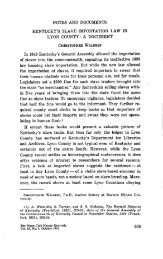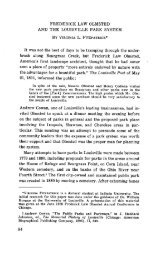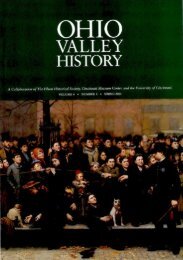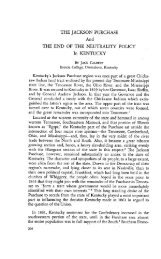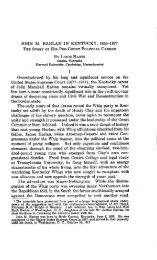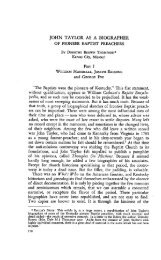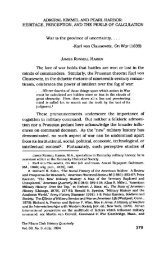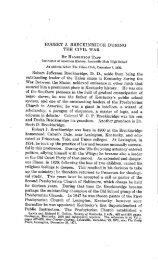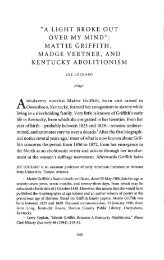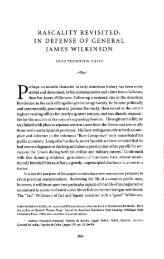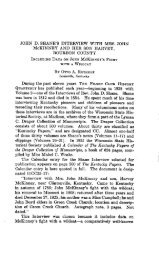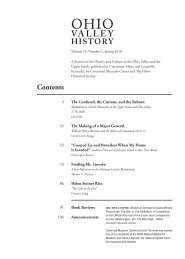Eskippakithiki, The Last Indian Town in Kentucky - The Filson ...
Eskippakithiki, The Last Indian Town in Kentucky - The Filson ...
Eskippakithiki, The Last Indian Town in Kentucky - The Filson ...
Create successful ePaper yourself
Turn your PDF publications into a flip-book with our unique Google optimized e-Paper software.
Vol. 6 ] <strong>The</strong> <strong>Filson</strong> Club History Quarterly 369<br />
first taste of the power of the French over the western Algonquians,<br />
and stimulated defensive measures everywhere. <strong>The</strong><br />
history of this affair had become so forgotten and misunderstood<br />
by the n<strong>in</strong>eteenth century that even so learned a historian of<br />
Western affairs as Dr. Reuben Gold Thwaites, <strong>in</strong> his Early Western<br />
Travels, says Peter Chartier took his Shawnees to the neighborhood<br />
of Detroit. In this Dr. Thwaites has doubtlessbeen<br />
misled by a letter written on October 28, 1745, by Governor Beauharnois<br />
to the French M<strong>in</strong>istry, which says:<br />
"<strong>The</strong> emigration of Chartier has at length taken place; they<br />
have removed from their former location to the place I allotted<br />
them at the Prairie of the Mascout<strong>in</strong>s; they have even tied and<br />
plundered the English traders on la Belle Riviere to the number of<br />
eight, and advise M. Longueville to send <strong>in</strong> search of them. But<br />
the detachment of fifteen or sixteen Canadians, despatched<br />
thither by that officer, discovered only one, and the Chaouanons<br />
-have said that they carried the others along with them to their<br />
w<strong>in</strong>ter quarters, and would br<strong>in</strong>g them to me themselves next<br />
year."1,<br />
<strong>The</strong> Prairie of the Mascout<strong>in</strong>s was <strong>in</strong> southern Michigan and,<br />
had our renegade Shawnees gone there, Dr. Thwaites' location<br />
would have been correct, but they did not go there. On August<br />
24 and 25, 1747, Longueville wrote the governor of Canada:<br />
"<strong>The</strong> Chaouanons of Chartier's tribe, so far from com<strong>in</strong>g to<br />
Detroit, accord<strong>in</strong>g to <strong>in</strong>vitation, have surprised some distant establishments<br />
[the Chickasaws] on the River of the Cheraquis and<br />
Alabanons [Tennessee]; though this Chartier, who has much <strong>in</strong>fluence<br />
over his tribe, excuses that evasion, assur<strong>in</strong>g that it will<br />
not be prejudicial to the attachment of these <strong>Indian</strong>s towards the<br />
French. It is to be feared either that he is not able to control<br />
them, or that he will himself change his op<strong>in</strong>ion."<br />
<strong>The</strong> attack on the "distant establishments" on the Tennessee<br />
River will be given later. Beauharnois letter shows how Charger<br />
was toy<strong>in</strong>g with the French. <strong>The</strong> w<strong>in</strong>ter quarters there<strong>in</strong> mentioned<br />
were, of course, Esldppakithiki, where Longueville's detachment<br />
of Canadians visited them, f<strong>in</strong>d<strong>in</strong>g only one of the despoiled<br />
traders. What a picture the conference between Chartier<br />
and the Canadians would make!<br />
Contemporary records of the years 1745 and 1746 are almost<br />
silent about <strong>Eskippakithiki</strong> and Chartier. This is additional rea-



